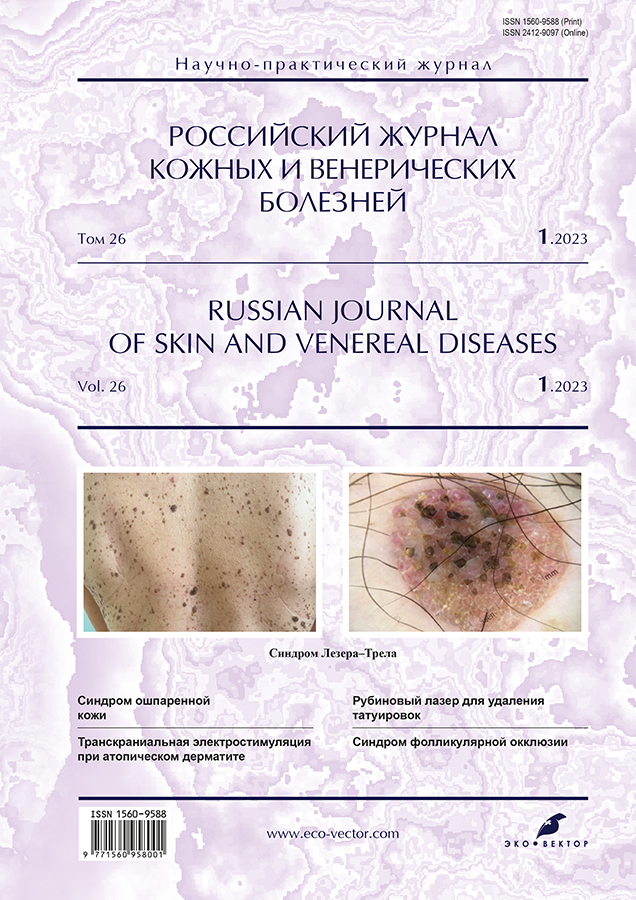Photogallery. Follicular occlusion syndrome
- Authors: Teplyuk N.P.1, Pirogova A.S.1, Svistunova D.A.2
-
Affiliations:
- I.M. Sechenov First Moscow State Medical University (Sechenov University)
- Saratov State Medical University named after V. I. Razumovsky
- Issue: Vol 26, No 1 (2023)
- Pages: 95-100
- Section: PHOTO GALLERY
- Submitted: 20.12.2022
- Accepted: 10.01.2023
- Published: 07.04.2023
- URL: https://rjsvd.com/1560-9588/article/view/119832
- DOI: https://doi.org/10.17816/dv119832
- ID: 119832
Cite item
Abstract
Hidradenitis suppurativa, dissecting cellulitis of the scalp, acne conglobata and pilonidal sinus ― are four diseases united by similar clinical findings and common mechanisms of pathogenesis. These conditions often coexist. The primer pathogenetic event is stratum corneum thickening and keratin plugging of the hair follicle ductal isthmus. The discovery of this mechanism led to association of all the diseases with the term "follicular occlusion syndrome". If three nosologies are detected follicular occlusion triad is diagnosed, if four are present ― follicular occlusion tetrad.
We present a photogallery on this problem.
Full Text
Рис. 1. Пациент Г., 25 лет. Диагноз: «Синдром фолликулярной окклюзии. Рассекающий целлюлит волосистой части головы. Гнойный гидраденит». На фотографии видны зоны очаговой потери волос, характерные для начальной стадии рассекающего целлюлита волосистой части головы. На этом этапе алопеция потенциально обратима.
Рис. 2. Тот же пациент. Единичный формирующийся абсцесс при гнойном гидрадените в области межъягодичной складки c созревающей пустулой.
Рис. 3. Тот же пациент. Трихоскопия в зоне очаговой потери волос: множественные чёрные точки, жёлтые 3Д-точки с волосяными стержнями и без них, веллусные волосы, фиолетовые зоны, белые зоны фиброза, немногочисленные pili torti (перекрученные волосы).
Рис. 4. Пациент Б., 19 лет. Диагноз: «Синдром фолликулярной окклюзии. Гнойный гидраденит. Конглобатные акне». Представлены конглобатные акне с формированием келоидных рубцов на спине, сходная картина наблюдается на груди и лице.
Рис. 5. Тот же пациент. Типичное поражение подмышечных областей при гнойном гидрадените. В локальном статусе обращает на себя внимание рубцевание и единичный воспалительный узел в области левой подмышки у пациента с двусторонним вовлечением, гнойный гидраденит в стадии разрешения, уменьшение выраженности воспалительных явлений.
Рис. 6. Пациент С., 39 лет. Диагноз: «Триада фолликулярной окклюзии. Рассекающий целлюлит волосистой части головы. Гнойный гидраденит. Конглобатные акне». В области волосистой части головы множественные подкожные свищевые ходы, соединяющиеся между собой; ассоциированная рубцовая алопеция с формированием келоидных рубцов, развивающаяся при отсутствии адекватного лечения на ранних стадиях.
Рис. 7. Тот же пациент. Конглобатный тип гнойного гидраденита по классификации Van Der Zee и Jemec, 2015 (высыпания в подмышечных и паховых областях не представлены на фотографиях). Обращают на себя внимание множественные двойные открытые псевдокомедоны, которые считаются типичным клиническим признаком гнойного гидраденита.
Рис. 8. Пациент С., 25 лет. Диагноз: «Синдром фолликулярной окклюзии. Гнойный гидраденит. Эпителиальный копчиковый ход». На фотографии представлен гнойный гидраденит половых органов и перианальной области: воспалительные узлы с гнойным отделяемым, рубцевание как исход предшествующих рецидивов и области поствоспалительной пигментации.
Рис. 9. Тот же пациент. Состояние после оперативного лечения эпителиального копчикового хода. Послеоперационная рана, заживающая вторичным натяжением, без признаков воспаления, с грануляциями.
Рис. 10. Пациент Г., 37 лет. Диагноз: «Синдром фолликулярной окклюзии. Гнойный гидраденит. Эпителиальный копчиковый ход». Состояние перед повторным оперативным лечением эпителиального копчикового хода в связи с рецидивированием процесса. В проекции межъягодичной складки определяется послеоперационный рубец. В нижней трети рубца определяется участок гипергрануляции.
Рис. 11. Тот же пациент. На фотографии виден неактивный очаг гнойного гидраденита в подмышечной области, представленный несколькими шнуровидными рубцами в исходе предшествующего воспалительного процесса.
About the authors
Natalia P. Teplyuk
I.M. Sechenov First Moscow State Medical University (Sechenov University)
Email: teplyukn@gmail.com
ORCID iD: 0000-0002-5800-4800
SPIN-code: 8013-3256
Russian Federation, Moscow
Anna S. Pirogova
I.M. Sechenov First Moscow State Medical University (Sechenov University)
Email: annese@mail.ru
ORCID iD: 0000-0002-2246-1321
SPIN-code: 1419-2147
Russian Federation, Moscow
Daria A. Svistunova
Saratov State Medical University named after V. I. Razumovsky
Author for correspondence.
Email: teplyukn@gmail.com
Russian Federation, Saratov
References
Supplementary files



















